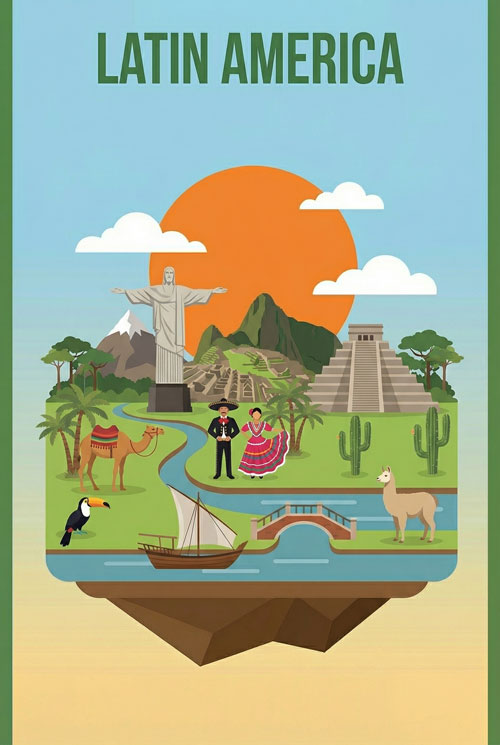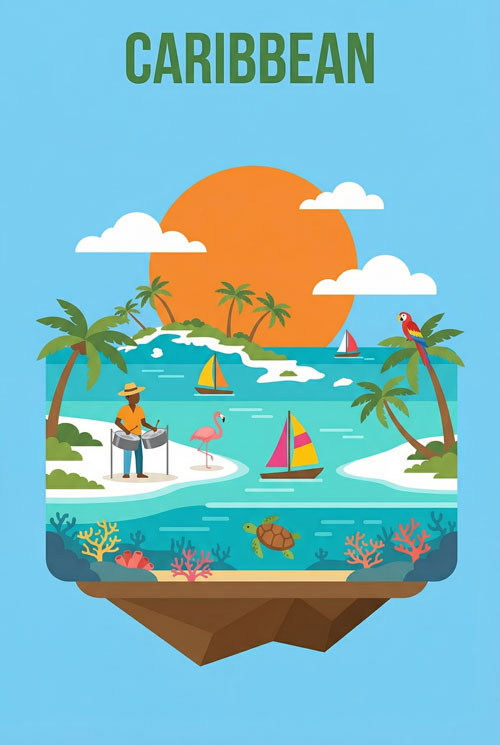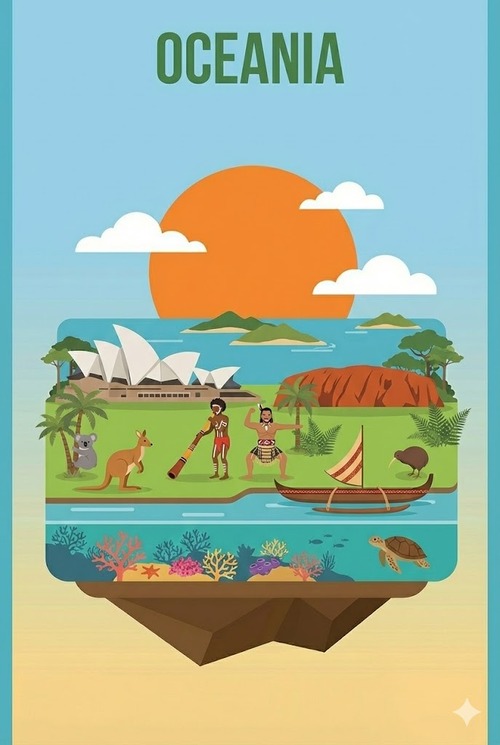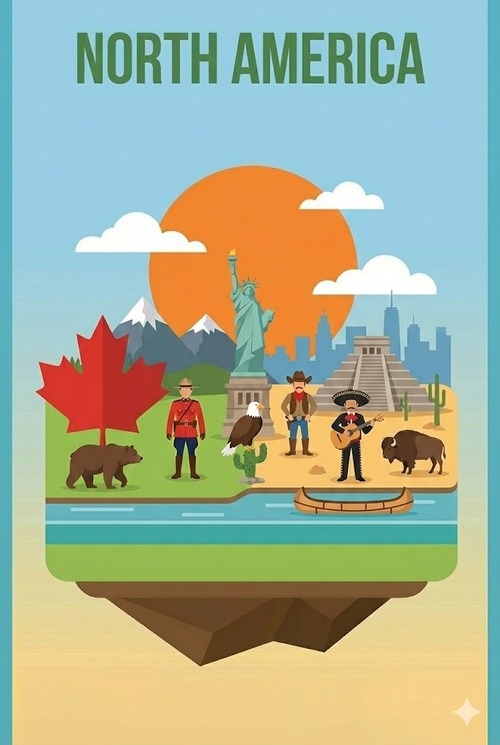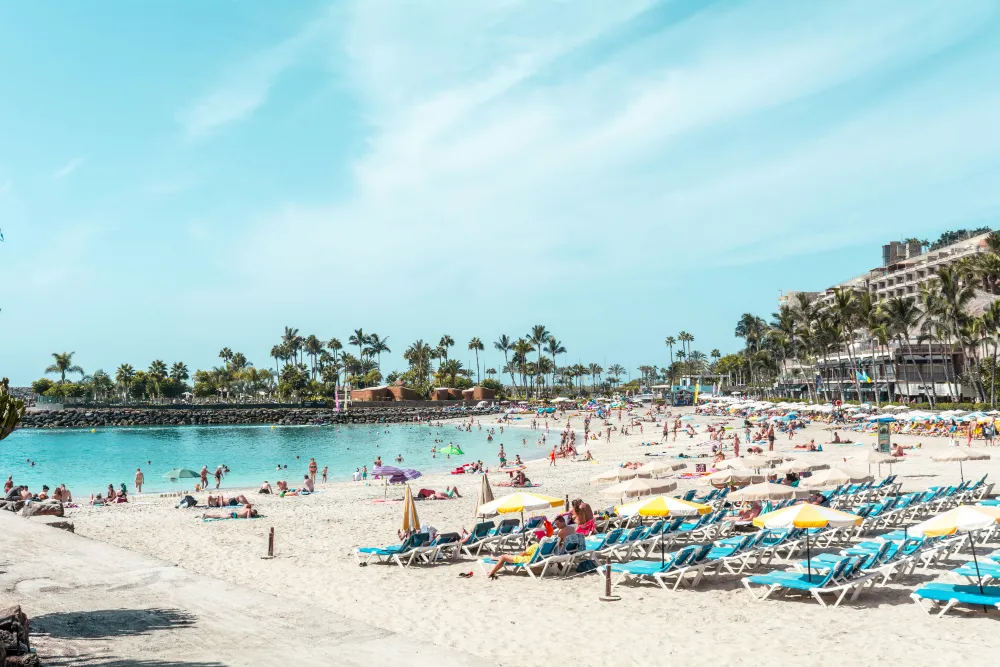eSIM Spain
Best Canary Island for Families | Best Family Guide
Your eight-year-old wants a waterpark. Your toddler needs calm beaches. Your budget says “be realistic.” And you have limited time to make everyone happy.
Here’s how to choose the right Canary Island without the guesswork—because no single island is perfect for everyone, and that’s the first thing you need to know.
Quick Island Comparison
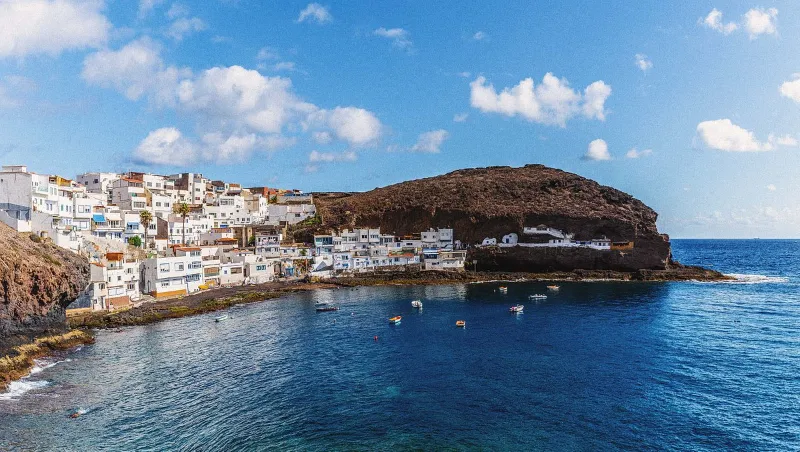
TENERIFE — The Everything Island
- Best For: Mixed ages (toddlers to teens), theme park lovers, all-in-one convenience
- Daily Budget: €80-150 for mid-range family stays
- Star Beach: Playa de las Teresitas (north, family-friendly)
- Key Drawback: Crowded during peak season, touristy south coast
- Don’t Miss: Siam Park (€42 adults, €30 kids), Loro Parque (€39 adults, €24 kids)
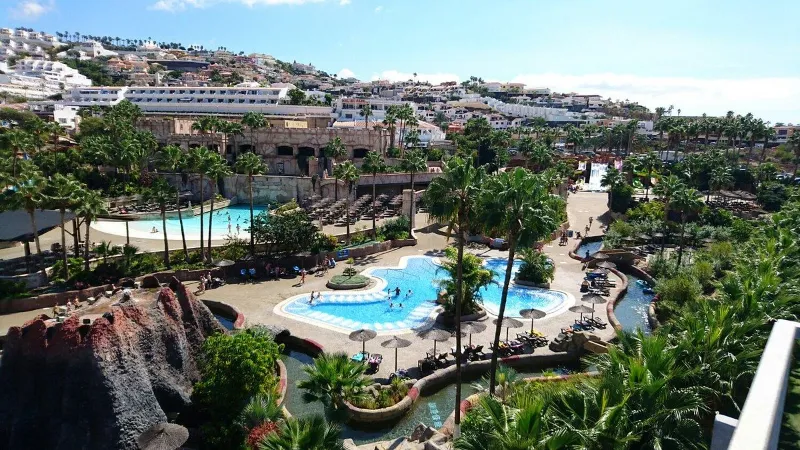
GRAN CANARIA — The Real Island
- Best For: Families wanting beaches + authentic city life, culture seekers
- Daily Budget: €70-120 for mid-range stays
- Star Beach: Playa de las Canteras (calm, urban, excellent facilities)
- Key Drawback: Less variety than Tenerife for activities
- Don’t Miss: Las Palmas neighborhoods, local markets, Vegueta historic center
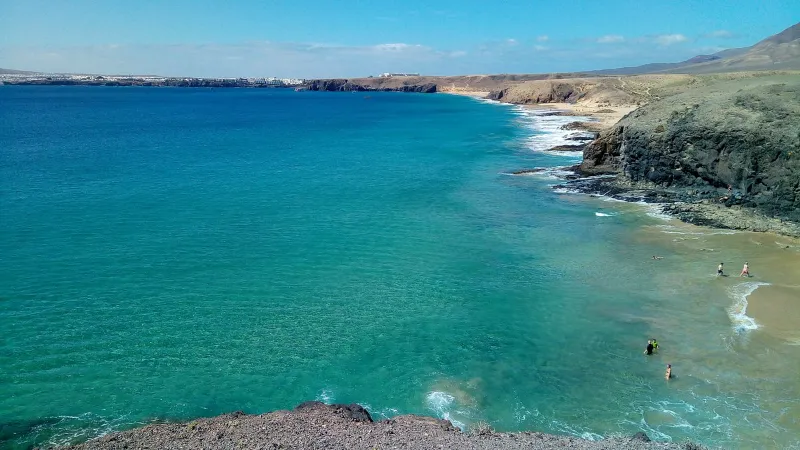
FUERTEVENTURA — The Calm Escape
- Best For: Beach-focused families, toddlers, slower pace, avoiding crowds
- Daily Budget: €60-100 for mid-range stays
- Star Beach: Caleta de Fuste (protected, shallow, perfect for little ones)
- Key Drawback: Windy conditions, fewer activities for energetic kids
- Don’t Miss: Corralejo dunes, authentic small villages
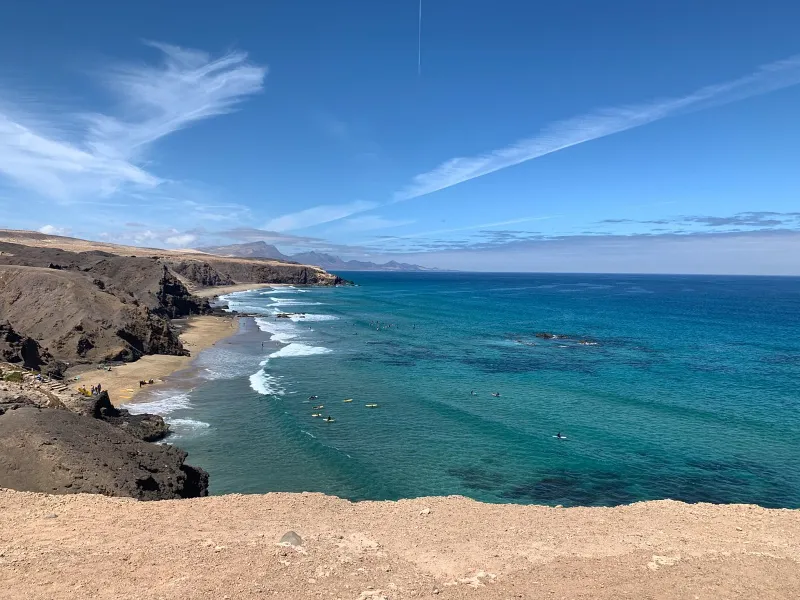
LANZAROTE — The Protected Paradise
- Best For: Toddler families, nature lovers, peaceful resorts, volcanic landscapes
- Daily Budget: €65-110 for mid-range stays
- Star Beach: Playa Flamingo (impossibly calm, breakwater-protected)
- Key Drawback: Fewer theme parks and structured activities
- Don’t Miss: Timanfaya National Park, César Manrique’s architectural sites
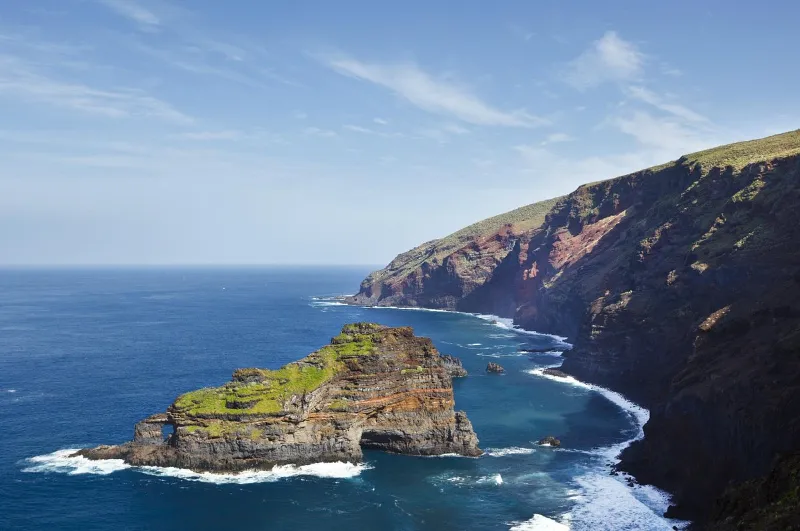
LA PALMA — The Active Adventurer
- Best For: Hiking families, nature enthusiasts, older children (8+)
- Daily Budget: €55-95 for mid-range stays
- Star Beach: Limited beach focus; mountains are the main attraction
- Key Drawback: Less infrastructure for very young children
- Don’t Miss: Caldera de Taburiente National Park, stargazing tours
🏝️ Which Canary Island is Perfect for Your Family?
Answer 8 quick questions to discover which island matches your family’s ages, budget, and travel style
How to Choose Based On Your Children’s Age
Your child’s age is the most important factor in picking a Canary Island. Too many families choose based on price or name recognition, then arrive frustrated because the island doesn’t match their kids’ needs.
Toddlers (0-3 Years): Calm, Safe, Easy
You need calm, protected beaches with excellent baby facilities and close medical care. Lanzarote and Fuerteventura excel here. Both have shallow, wave-free beaches perfect for tiny kids. Tenerife’s south coast works too, but avoid the party zones around Playa de las Américas.
Deal breaker: Avoid beaches with steep entries, strong currents, or limited shade. Stroller access matters more than you’d think—not all beaches have paved paths.
What parents say: “I was terrified about beach strollers sinking in sand. Playa Flamingo solved this. The paved promenade meant we could stroll without pushing through sand. Shaded areas kept the babies cool. We felt safe and comfortable the entire week.” — Sarah, traveling with 18-month-old twins
Essential for this age: Close proximity to accommodations (10-minute walks maximum), quiet neighborhoods for naps, easy access to pharmacies and pediatric care.
Young Children (4-8 Years): Activity + Beach Balance
Look for islands with both beaches and activities. Tenerife offers the most entertainment options but feels most crowded. Gran Canaria balances beaches with city exploration. Fuerteventura and Lanzarote give families relaxed beach days plus enough activities to prevent boredom.
This age group thrives on waterparks, small zoos, local markets, and boat tours—anything that combines novelty with manageable stimulation.
Deal breaker: Islands with limited dining variety (picky eaters struggle) or beaches that require long walks from parking.
What parents say: “My 8-year-old has sensory issues. Fuerteventura was perfect. Fewer crowds meant quieter beaches and restaurants. He didn’t get overwhelmed like he would in tourist hotspots. Exactly what we needed.” — Marcus
Tweens & Teens (9+ Years): Independence + Interest
Consider what genuinely interests them. Water sports enthusiasts prefer Fuerteventura and Lanzarote. Thrill-seekers want Tenerife’s theme parks. Active outdoors kids love La Palma’s trails. Teens who appreciate real culture enjoy Gran Canaria’s museums and old towns.
At this age, they’re often content with beaches, interesting food, and some activity choices—they don’t need constant entertainment.
Deal breaker: Forcing teens into activities designed for younger kids. They’ll disengage entirely.
What parents say: “We chose Lanzarote because windsurfing interested my 14-year-old. She actually got lessons and felt like she accomplished something real. More than a passive vacation, it was an experience she talks about constantly.” — Jennifer
Mixed-Age Families: The Compromise Strategy
Tenerife usually wins because it offers something for every age. Yes, it’s busier and pricier, but the variety helps everyone stay happy. The alternative is Gran Canaria, which provides good beach access for younger kids and cultural exploration for older ones.
Strategy: Split your week. Spend 3 days doing younger-kid activities, 2 days on teen interests, and 2 days where everyone picks together.
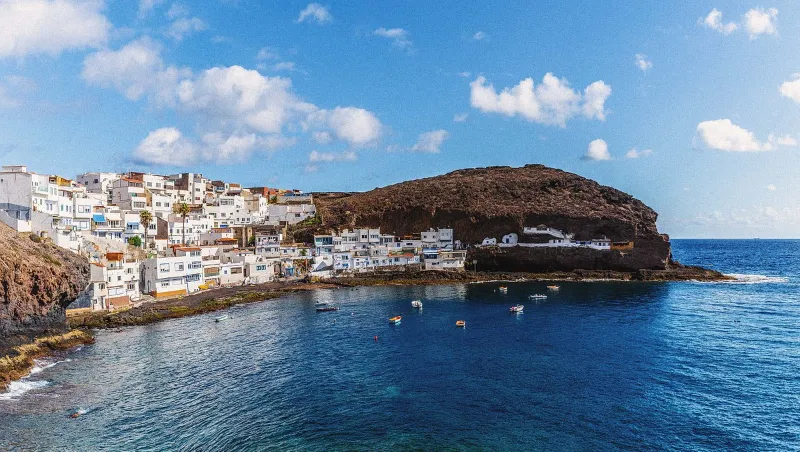
Tenerife: The All-In-One Island (But Choose Your Neighborhood Wisely)
Tenerife is Spain’s most visited island for good reason—it has everything. But “everything” also means choosing wisely about where you stay, because the island has dramatically different personalities depending on location.
South Coast: The Resort Zone
Neighborhoods: Playa de las Américas, Los Cristianos, Costa Adeje
This area feels like a theme park itself. Restaurants, shops, and hotels line every street. Siam Park and Loro Parque are nearby. Daily crowds can reach overwhelming levels during school holidays—think wall-to-wall tourists on beachfront promenades.
What it costs: €90-150 nightly for mid-range family rooms. Add €4-5 daily for sunbed rental, €2-3 for parking if you rent a car.
Weather reality: The south gets very hot—80-85°F even in winter. Air conditioning isn’t optional; it’s essential. Without it, toddlers struggle with afternoon naps.
Who thrives here: Families wanting organized fun who don’t mind crowds. Easy access to activities means less planning stress. Everything is in English. You’ll never struggle to find kid-friendly restaurants.
Who struggles here: Families seeking authentic Spain, quiet evenings, or budget-conscious travelers (everything carries a tourist markup). Nightlife zones exist here too, so research your specific hotel’s location carefully—some streets get loud until 2 AM.
North Coast: The Authentic Alternative
Neighborhoods: Puerto de la Cruz, La Orotava, Santa Cruz
The north is cooler, windier, and significantly quieter. Temperatures run 60-70°F even in summer—which means you’ll save on air conditioning but your kids might need long sleeves for evening beach walks. Fewer tourists means easier beach access and shorter lines everywhere. Neighborhoods feel more Spanish and less resort-like.
What it costs: €60-100 nightly for mid-range accommodations—30% cheaper than the south for comparable quality.
Who thrives here: Families wanting calm and authenticity, who don’t mind cooler weather and occasional wind. Perfect if your family overheats easily or prefers sweater weather to scorching sun.
Top family beaches in the north: Playa Flamingo and Playa de las Teresitas both offer manageable waves, smaller crowds, and good shade with baby-changing facilities.
Getting Around Tenerife
Public transport: Frequent buses cost €1.50 per ride, with day passes at €7.50. They’re modern and stroller-friendly but get crowded during peak hours (8-9 AM, 5-7 PM).
Car rental: €25-40 daily gives you freedom to explore mountain villages and less touristy beaches. Many families do both—rent a car for 3-4 days to explore, then use buses for beachside days.
Pro tip: If you’re staying in the south and want to visit the north (or vice versa), expect a 45-60 minute drive. Factor this into daily planning with young kids who struggle with car rides.
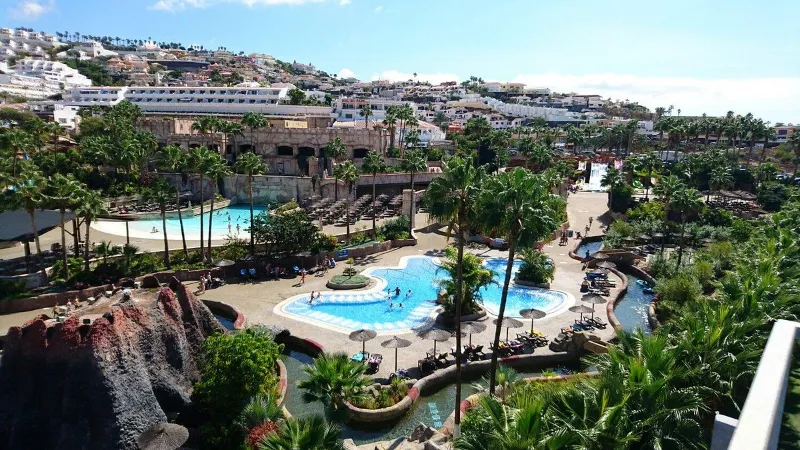
Gran Canaria: The Underrated Island With Real City Life
Gran Canaria isn’t as famous as Tenerife, but it shouldn’t be overlooked for families. It offers beaches, genuine city exploration, and less overwhelming crowds—all at better value.
Las Palmas: Where Locals Actually Live
The capital isn’t a resort town. You’ll find real restaurants, authentic markets, and neighborhoods where kids see how islanders actually live. Playa de las Canteras is an excellent family beach right in the city—calm water, soft sand, manageable crowds even in summer.
What it costs: €65-100 nightly for mid-range family accommodations near the beach.
Why this matters: Your kids experience real Spain without sacrificing convenience. You’re eating where locals eat, shopping where locals shop, yet still have beach access and tourist infrastructure when needed.
What parents say: “Gran Canaria’s Las Palmas neighborhood saved us money. Grocery store near our apartment, local restaurants, no tourist markup. We spent half what Tenerife would have cost for the same week.” — David
Southern Resorts: The Familiar Option
Neighborhoods: Playa del Inglés, Maspalomas
These areas offer more of what you’d expect: hotels, restaurants, waterpark access. Aqualand costs €28-35 for adults, €20-25 for kids. Family rooms run €75-120 nightly. The zones feel touristy but are well-organized and safe.
The value play: Look for accommodations one block inland from the beach. Prices drop 20-30%, noise drops even more, and you’re still a 2-minute walk from the sand.
Neighborhoods Worth Exploring
Vegueta (historic center): Narrow cobblestone streets perfect for exploring with kids. Authentic architecture, small museums, local ice cream shops.
Triana (shopping district): Where locals actually shop and eat. Pedestrian-friendly, full of real cafes and playgrounds.
Both are walkable and feel authentic without being overwhelming for families.
Getting Around Gran Canaria
Modern, stroller-friendly buses with day passes at €7. Taxis are affordable and available everywhere. A rental car isn’t necessary if you stay near good bus routes, though some families rent for 1-2 days to visit inland villages like Tejeda or Teror.
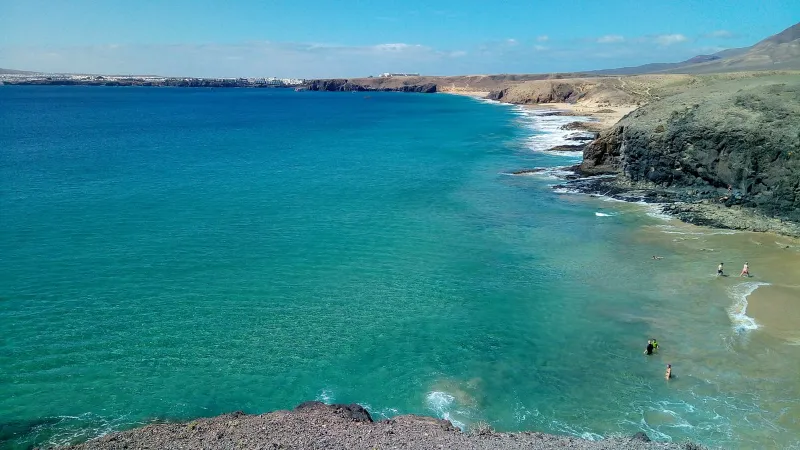
Fuerteventura: Calm Beaches and Low-Key Family Life
Fuerteventura is Spain’s third-most-visited island but somehow feels the least crowded. Families seeking peace and simple beach days often choose this island—and rarely regret it.
Caleta de Fuste: The Family Base
The main tourist town doesn’t feel overdeveloped. Beaches are protected, shallow, and perfect for toddlers and young children. Water stays calm most days. A long promenade runs along the beach with restaurants, ice cream shops, and shaded rest areas.
What it costs: €55-90 nightly for family accommodations.
The reality: This isn’t an activities-packed destination. You’re here for beaches, relaxation, and simple pleasures. If your family needs constant stimulation, look elsewhere. If your family thrives on calm, this is paradise.
Corralejo: The Busier Alternative
Northern Fuerteventura offers a different vibe—busier than Caleta de Fuste but still low-key by Canary standards. Dramatic dunes and beaches create stunning landscapes. Windy conditions make it popular with windsurfers and kitesurfers, which means older kids enjoy watching water sports.
Important: This isn’t ideal for toddlers who need complete calm. Wind and waves pick up regularly.
What it costs: €65-100 nightly for family rooms.
Authentic Village Life
For the quietest experience, skip the main towns entirely. Stay in Puerto del Rosario or smaller villages like Pajara. You’ll find more authentic island life, fewer tourists, and exceptional value—accommodations drop to €45-70 nightly.
Trade-offs: Fewer restaurants, less English spoken, more planning required. This suits adventurous families, not those wanting turnkey convenience.
Getting Around & Weather Reality
Transport: Buses run between main towns (€3-5 per ride) but frequency is low. Many families rent a car for the whole week (€150-200 total) because independence matters more here—beaches are spread out and you’ll want to explore.
Weather note: Fuerteventura is consistently windy. Even in summer, breezes are constant. This keeps temperatures comfortable (65-80°F) but means beach days can feel cool for sensitive kids. Pack layers, even in July.
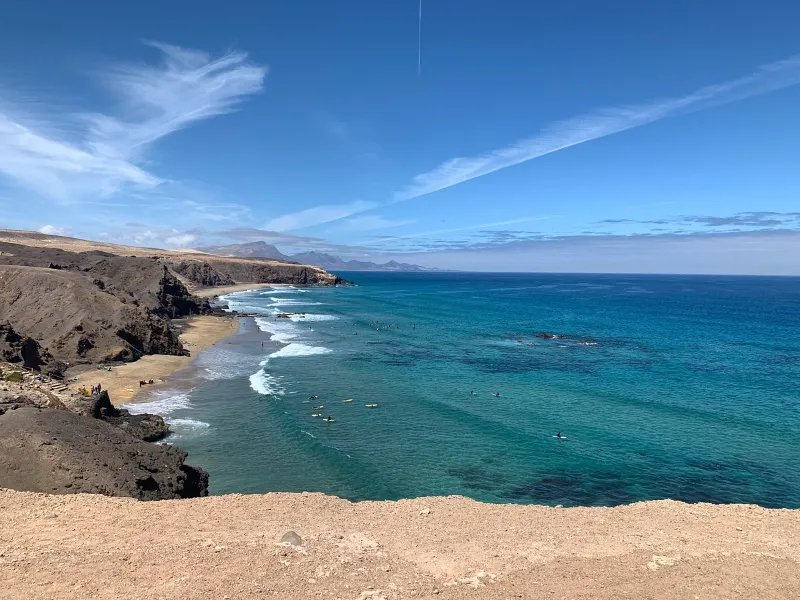
Lanzarote: Protected Beaches and Authentic Charm
Lanzarote offers something unique among Canary Islands: protection from overdevelopment. Much of the island is a UNESCO Biosphere Reserve, which means fewer high-rise hotels and more preserved nature.
Playa Flamingo: The Toddler Paradise
This beach is the standout for families with toddlers. Protected by a breakwater, it creates impossibly calm, shallow water. Waves rarely exceed 6 inches. Sand is soft. Shade and facilities are excellent.
Why parents rave about it: Kids can play safely in water that’s warm, clear, and gentle. Adult supervision is still required, but conditions are as close to ideal as you’ll find anywhere in Europe.
What it costs: Nearby accommodations run €70-100 nightly. The beach itself is free with public facilities.
Costa Teguise & Puerto del Carmen
Both towns offer family-friendly atmospheres without feeling overrun. Costa Teguise has excellent shallow beaches and a relaxed vibe. Puerto del Carmen provides more restaurants and evening entertainment.
What it costs: €65-110 nightly for mid-range family stays across both areas.
Volcanic Adventures for Families
Timanfaya National Park offers family-friendly volcanic tours that feel genuinely unique. Kids love the geothermal demonstrations (water poured into the ground shoots back as steam) and the otherworldly landscape.
Tour details: €12 adults, €6 children. Tours are 30-40 minutes, manageable for most ages 5+.
César Manrique sites (artist centers and attractions) appeal to families with older kids interested in art and architecture. Admission: €10-15 per person.
Getting Around Lanzarote
The island is small and easy to navigate. Buses connect major towns (€1.50-3 per ride). Car rental is popular (€150-180 weekly) and gives access to hidden beaches and small villages worth exploring.
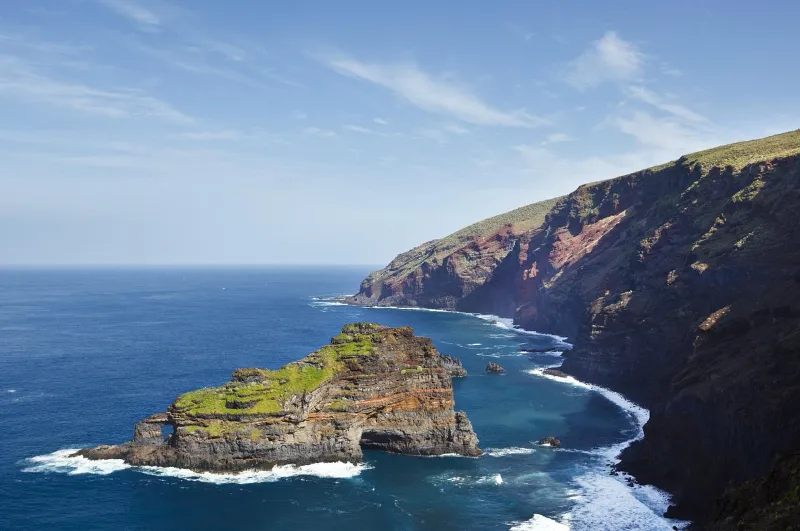
La Palma: The Active Family’s Island
La Palma works for active families who enjoy hiking, nature, and authentic island life. This isn’t a beach-resort destination—it’s a mountains-and-trails destination that happens to have a few good beaches.
Who Thrives Here
Families with older children (8+) who love outdoors activities. Caldera de Taburiente National Park offers stunning hikes suitable for fit families. Stargazing tours leverage La Palma’s designation as a Starlight Reserve—some of the world’s clearest night skies.
What it costs: €55-95 nightly for mid-range accommodations. Fewer tourists mean real neighborhoods, local markets, and genuine island life.
Who This May Not Be For
Families with toddlers or young children needing constant beach access and structured activities. Infrastructure is limited compared to other islands. You need to be comfortable with more independence and planning.
Beach note: Beaches exist but aren’t the island’s strength. Come for mountains, forests, and authentic culture—not for lounging on sand.
Getting Around
A car is essential on La Palma. Public transport exists but is minimal. Expect to rent for your entire stay (€150-200 weekly). Roads are winding and mountainous—factor in longer travel times than distances suggest.
Stop Overpaying in Roaming Fees (Or Wasting Time Hunting for Local SIM Cards)
Overseas travel often means choosing between outrageous roaming charges or scrambling for local SIM cards the moment you land.
One drains your budget. The other steals time away from your holiday.
Smart travelers are now switching over to eSIMs.
eSIMs give you data at a fraction of the cost of what your telco charges for roaming and most modern phones have eSIM technology set up – (although you’ll need to check your phone’s compatibility here).
How eSIM4.com Works:
- Step 1: Pick your destination and data plan
- Step 2: Scan our QR code (takes 3 minutes)
- Step 3: Land overseas with instant local network access
No queues. No tiny plastic cards. No bill shock.
Just seamless, affordable data from the moment you land.
Stop letting phone companies raid your travel budget. Join the smart travelers who’ve already switched.
Get Your eSIM NowSafety Guide: What You Actually Need to Know
The Canary Islands are exceptionally safe for families. Crime rates are low, healthcare is excellent, and tourism infrastructure is well-developed. That said, smart preparation matters.
Beach Safety: The Real Concerns
Currents and waves vary dramatically by beach and day. Always check flags:
- Green: Safe for swimming
- Yellow: Caution (strong swimmers only)
- Red: No swimming allowed
Never ignore red flags. Currents can be powerful, and drowning incidents do occur when families disregard warnings.
Toddler supervision: Even on calm beaches with shallow water, constant adult supervision is non-negotiable. Kids can get into trouble in inches of water.
Sun protection: UV intensity is stronger than northern Europe. Reapply sunscreen every 90 minutes, not just after swimming. Use SPF 50+ for children.
Health & Medical Care
Healthcare quality is excellent across all islands. Public hospitals have emergency services, and most doctors speak English in tourist areas.
European Health Insurance Card (EHIC) covers EU citizens for necessary medical care. Non-EU visitors should have travel insurance.
Pharmacies (“farmacias”) are widespread and well-stocked. Pharmacists can help with minor issues and often speak English.
Common issues: Sunburn, dehydration, minor cuts/scrapes, upset stomachs from different food. Nothing unexpected.
Emergency number: 112 (works from any phone, even without credit)
Practical Safety Tips
Petty theft exists in tourist areas. Keep valuables in hotel safes. Don’t leave bags unattended on beaches. Use anti-theft bags in crowded markets and buses.
That said: Violent crime against tourists is exceptionally rare. You’re more likely to encounter pickpocketing than any physical threat.
Kids wandering off: Crowded beaches and markets present the real risk. Use wristbands with your phone number for young children. Establish meeting points before exploring.
Food safety: Restaurants are held to high hygiene standards. Tap water is safe to drink on most islands (bottled is available everywhere if you prefer).
What Travel Insurance Should Cover
At minimum: Medical emergencies, trip cancellation, lost luggage, and weather disruptions. Hurricane season (June-November) occasionally affects islands—direct hits are rare, but wind and rain happen.
Cost: €50-100 for a family of four for one week. Worth every cent for peace of mind.
Hidden Costs To Be Aware Of
Most families underestimate total costs by 15-20% because they forget these expenses:
Sunbed & umbrella rental: €4-5 daily per set. For a week, that’s €30-35—and you probably want two sets for a family.
Parking fees: €2-3 daily if you rent a car. Beach parking, attraction parking, hotel parking (not always free).
Tourist tax: €1-3 per person per night, depending on accommodation type. For a family of four staying one week: €28-84.
Airport transfers: Taxis cost €25-50 from airport to resort areas. Buses are cheaper (€3-6) but take longer with luggage and tired kids.
Activity costs add up: One waterpark visit, one boat tour, one national park, beach equipment rentals—suddenly you’re at €200+ for activities alone.
Ice cream, snacks, souvenirs: Budget €10 daily for these “little extras.” They’re not little when you’re buying them three times a day.
Restaurant drinks: Water, soft drinks, and juice add €8-15 per meal for a family. Consider buying drinks at supermarkets to bring to restaurants (check if allowed).
Resort fees: Some hotels charge for WiFi, safes, or pool towels. Ask before booking.
Cost-Cutting Strategies That Actually Work
Rent an apartment with a kitchen. Cooking breakfast and some dinners saves €30-50 daily for a family of four.
Shop at local supermarkets like Mercadona, HiperDino, or Lidl. Prices are 40-60% lower than resort convenience stores.
Visit beaches without sunbed rentals. Bring your own beach umbrella and towels. One-time purchase (€25-35) saves money over multiple days.
Drink tap water. It’s safe on most islands. Carry refillable bottles instead of buying bottled water constantly.
Eat lunch as your main meal. Many restaurants offer “menú del día” (menu of the day) at lunch with better value than dinner.
Free activities: Beaches (obviously), hiking trails, town explorations, local markets, playgrounds.
Book accommodations early. Three months before travel during peak seasons saves 20-30% versus last-minute booking.
Best Time to Visit: Month-by-Month Reality Check
The Canary Islands have year-round good weather, but “good” depends on what your family needs.
Winter (December-February)
- Temperature: 60-70°F on south coasts, 55-65°F on north coasts
- Best for: Toddlers who overheat easily
- Crowds: Peak season—especially January through March
- Prices: Highest of the year
- Rain: Possible but not constant
- Bottom line: Near-perfect weather but expect crowds and premium prices
Spring (March-May)
- Temperature: 65-75°F, minimal rain
- Best for: All ages—ideal conditions
- Crowds: Moderate, less than winter
- Prices: Lower than winter, better value
- Bottom line: Best value season for families seeking excellent weather without peak crowds
Summer (June-August)
- Temperature: 80-90°F with low humidity
- Best for: Families who love heat and don’t mind crowds
- Crowds: Very high, especially July-August
- Prices: Peak pricing returns
- Bottom line: Hot for toddlers and heat-sensitive kids. Afternoon siestas become necessary. Beach umbrellas non-negotiable.
Fall (September-November)
- Temperature: 70-80°F, occasional rain
- Best for: Families wanting warm weather with fewer tourists
- Crowds: Lower, especially October-November
- Prices: Good value
- Bottom line: September can still be warm; October-November hits the sweet spot of weather + value + manageable crowds
North vs. South Coast Weather
North coasts (Tenerife, La Palma) are consistently cooler and windier. Good for families who overheat easily, less ideal for those wanting guaranteed warm beach weather.
South coasts (everywhere) are sunnier, hotter, and more reliable. Better for beach-focused families, but plan for serious sun protection.
Authentic Experiences Beyond Theme Parks
Tourist attractions are fine, but real memories come from local experiences your kids will actually remember years later.
Local Markets: Free Entertainment
Most towns have weekly markets where locals shop—not tourist traps, genuine markets. Kids love the sounds, smells, and energy. Fresh fruit, local cheese, pastries, and people-watching.
When: Early morning (6-11 AM)
Cost: Free to attend, buy only what you want
Best markets: Las Palmas (Gran Canaria), Arrecife (Lanzarote), Puerto del Carmen (Lanzarote)
Town Fiestas: Unexpected Magic
Local celebrations happen year-round. These are for locals, not tourists—which makes them special. Kids enjoy parades, music, food stalls, and energetic crowds.
How to find them: Check local tourism office websites or ask your hotel. Most are free or low-cost.
What to expect: Loud music, traditional costumes, street food, dancing. Arrive early for best viewing spots.
Farm Visits & Animal Experiences
Most islands offer farm visits with animal interactions. Young children love feeding goats, seeing chickens, and learning about rural island life.
Cost: €15-30 per person, often includes snacks or lunch
Duration: 2-3 hours
Pro tip: Ask your accommodation host for recommendations. They know the best local farms, not just the touristy ones.
Eat Where Locals Eat
Skip restaurants with photos on menus. Look for places filled with Spanish-speaking families. Menus may be Spanish-only, but pictures on your phone help. Kids’ meals cost €5-8 versus €12-15 at tourist spots.
How to find them: Walk two blocks away from main tourist streets. Ask locals. Look for “menú del día” signs.
Why it matters: Your kids taste real food and experience genuine culture. Plus you save 30-40% on meal costs.
Hidden Beach Exploration
Main tourist beaches are fine, but small, local beaches create special memories. Drive or walk to lesser-known spots. You’ll encounter locals, simpler facilities, and authentic island life.
These moments stick with families more than theme parks ever will.
Grocery Shopping as Cultural Experience
Let kids explore supermarkets. They enjoy seeing unfamiliar products, trying new snacks, and comparing prices. It’s cultural exploration disguised as grocery shopping.
Bonus: You save money on snacks and drinks while kids learn about different food cultures.
Budget Breakdown: Real Numbers for a Family of Four
Here’s what a realistic week costs for a family of four (two adults, two kids ages 6 and 10).
| Category | Daily Cost | Weekly Total |
|---|---|---|
| Accommodations | €90/night (mid-range apartment with kitchen) | €630 |
| Meals | €120 (breakfast at home, lunch out, dinner at affordable restaurant) | €840 |
| Activities | €50 (museums, waterpark, beach rentals, boat tour) | €350 |
| Transport | €22/day (€150 weekly car rental ÷ 7 days) | €150 |
| Sunbed/umbrella rental | €10 (4 beach days × €10 per day for family) | €40 |
| Miscellaneous | €8 (ice cream, souvenirs, tips) | €56 |
| Tourist tax | €8 (€2/person/night × 4 people) | €56 |
| TOTAL FOR SEVEN DAYS | €2,122 | |
| Per person per day | €76 |
Budget Travel (€1,400-1,600 weekly)
- Self-catering apartment with most meals cooked
- Free beaches and hiking, minimal paid attractions
- Public transport instead of car rental
- Off-season travel
Luxury Travel (€3,000+ weekly)
- Resort hotel with half-board or all-inclusive
- Multiple paid attractions and tours
- Car rental plus taxis when convenient
- Premium restaurants several times weekly
The framework shows you where money goes and where to adjust based on your priorities.
Common Mistakes Families Make (And How to Avoid Them)
Mistake #1: Choosing Based on Price Alone
The cheapest island might not fit your family’s needs. A frustrated week on the wrong island costs more than paying slightly more for the right one.
Fix: Match island to your family’s age and activity level first, then find value within that choice.
Mistake #2: Staying in the Wrong Neighborhood
Booking a “great deal” in a party zone with toddlers, or a quiet village with teens who need stimulation.
Fix: Ask hotels directly: “Is this neighborhood quiet at night?” Read recent reviews about noise levels.
Mistake #3: Underestimating Hidden Costs
Families budget for flights and hotels, then blow their budget on unexpected expenses.
Fix: Add 20% to your estimated costs for the expenses outlined in the Hidden Costs section above.
Mistake #4: Overpacking the Schedule
Trying to see and do everything creates exhausted, cranky kids and stressed parents.
Fix: Plan 1-2 activities per day maximum. Build in beach time, rest time, and flexibility.
Mistake #5: Ignoring Weather Patterns
Booking north coast accommodations expecting hot beach weather, or south coast stays in peak summer with heat-sensitive toddlers.
Fix: Match your accommodation location to your family’s weather preferences and tolerance.
Final Decision Checklist
Before booking, confirm your choice with these questions:
✅ Does the island match your kids’ ages and energy levels?
Theme park kids need Tenerife. Beach kids fit anywhere. Nature kids need La Palma. Toddlers thrive in Lanzarote’s calm.
✅ Have you added 15-20% to your budget for hidden costs?
Sunbeds, parking, snacks, activities, tourist tax, tips—they add up fast.
✅ Does your transport choice fit your travel style?
Hate driving? Pick an island with good buses. Want flexibility? Rent a car even if more expensive.
✅ Is your neighborhood genuinely quiet or touristy?
Ask the hotel specifically. Don’t assume based on photos alone.
✅ Does your travel season match your calendar and budget?
School holidays = peak prices and crowds. Off-season = savings but fewer activity options.
✅ Are you booking early enough?
Three months ahead for peak seasons (December-February, Easter, summer) saves 20-30%. Off-season allows one-month booking windows.
For Families with Mixed Ages (Toddler + Older Child)
Choose: Tenerife, Costa Adeje (south coast, avoid party zones)
Why: Theme parks for older kids, calm beaches for toddlers, maximum variety
Stay: 7 nights, family suite or apartment
Budget: €2,000-2,400 weekly
For Families Seeking Authenticity on a Budget
Choose: Gran Canaria, Las Palmas neighborhood
Why: Real city life, excellent beach, local restaurants, best value
Stay: 7 nights, apartment near Playa de las Canteras
Budget: €1,500-1,800 weekly
The best Canary Island for your family isn’t the most popular one or the cheapest one—it’s the one that matches your kids’ ages, your budget reality, and your travel style.
Tenerife delivers variety and convenience at premium prices. Gran Canaria offers authenticity with tourist infrastructure. Fuerteventura provides calm beaches and relaxed pace. Lanzarote gives protected waters and volcanic beauty. La Palma rewards active families with nature and adventure.
Choose based on what your family genuinely needs, not what travel brochures promise. Add 20% to your budget estimate. Book accommodations three months early for peak season. And remember: the memories your kids treasure won’t be from the most expensive attraction—they’ll be from the moments you connected as a family.
Now go book that trip. The islands are waiting.








